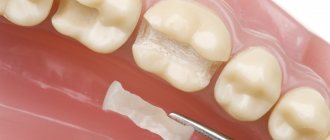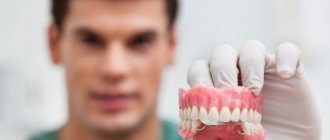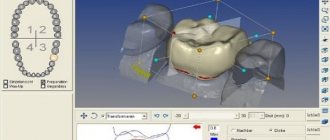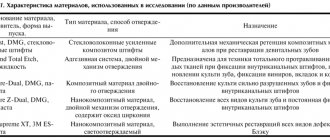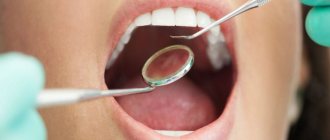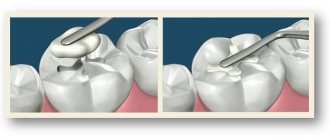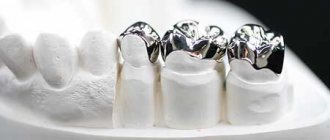Installing crowns is one of the most effective ways to restore teeth. How can you determine that the prosthesis is of adequate quality and that the fixation procedure was carried out according to all the rules? It’s very simple: artificial teeth should not be visually different from real teeth. By and large, such a result can only be achieved if two conditions are met: the doctor installing ceramic crowns must be a true professional, and the structure itself is made of solid ceramics. Andrey Nikolaevich Karneev, leading orthopedist at the German Implantology Center, spoke about what a ceramic crown on a tooth is.
What are the advantages of a ceramic crown?
Today, ceramic dental crowns are the most aesthetically pleasing orthopedic structures installed both in the smile area and on chewing teeth. Ceramics is biologically inert and indifferent, is not perceived by the body as something foreign, does not absorb foreign odors, pigments and bacteria, does not emit harmful substances, and is also very durable. High-quality dentures cannot be distinguished from natural teeth.
3 main advantages of ceramic crowns
- Superior Aesthetics
- Hypoallergenic
- Reliability
Classification of ceramics by level of transparency
The level of transparency of dental ceramics is indicated in Latin letters:
- HT (High Translucency) – high transparency;
- LT (Low Translucency) – low transparency;
- MO (Medium Opacity) – medium opacity;
- HO (High Opacity) – high opacity.
These four levels are typical only for glass ceramics. Oxide ceramics only meet the HO level. Zirconium oxide belongs to the MO level and does not correspond to the specified HT. The higher level of transparency of zirconium oxide is explained by a decrease in the porosity of the material. Less porous - scatters light less, acquires transparency and higher strength.
The choice of ceramics with a particular transparency depends on the type of denture and the color of the supporting tooth. Highly transparent ceramics are suitable for partial restorations and are not suitable for crowns due to the prospect of translucency of the dark oral cavity. Monolithic dentures are recommended to be made from HT and LT ceramics. To completely or partially cover the shade of the prepared tooth, HO and MO are used.
What types of ceramic crowns are there?
Pressed ceramic crown
The most advanced type is the pressed ceramic crown. The design is highly durable, more accurately reproduces the color of natural teeth, and to install the prosthesis there is no need for strong grinding of the teeth, as is required for fixing structures made from other materials. The last advantage is extremely important, since the service life of the prosthesis depends on the amount of preserved natural dental tissue.
The most famous types of dentures made of pressed ceramics are created using E-max and Empress technologies.
- The E-max ceramic crown is made of lithium disilicate, that is, glass ceramics, which has a high degree of strength and is ideal for prosthetics in both the anterior and chewing regions.
- The Empress ceramic crown is made from the same material, but with the addition of leucite crystals, a mineral of igneous origin. The structures have excellent aesthetic characteristics, but are not able to withstand heavy loads, so they are installed only in the smile area.
Ceramic zirconium crowns
Often, prostheses made of zirconium are classified as metal-free ceramic crowns, which is fundamentally incorrect. Zirconium dioxide is the same metal, only white. Unlike ceramics, it does not have sufficient transparency, and its color palette is very limited. But, on the other hand, this material has good strength. Which crowns are better – ceramic or zirconium? Zirconium dioxide ceramic crowns are more suitable for restoring chewing teeth. In the frontal section, preference should be given to designs made of metal-free ceramics.
Ceramic crowns on a zirconium dioxide frame
A crown on a zirconium base, coated with a layer of ceramics, is the latest development in prosthetics. The white material, unlike metal, does not shine through the porcelain shell, which allows you to achieve excellent aesthetic results with high strength and wear resistance of the structure. In addition, the biocompatibility of a ceramic crown on a zirconium frame eliminates the risk of allergies and periodontal inflammation.
Other ceramic options by type of transparency
They also produce so-called multiblocks, which combine different layers of opacity, imitating enamel and dentin. Within such a block, dentists can vary the position of the milled restoration, obtaining, for example, a more transparent incisal edge or a more saturated color of the gingival part.
There are also ceramic materials in pink shades that imitate the gingival part of a denture. This is especially true for combined work with implant support. Manufacturers strive to standardize the colors of ceramic, resin, and composite materials to make it as easy as possible for dentists to achieve color matches.
Ceramics in dentistry also differ in thickness. The stronger the material, the thinner its thickness. For example, the minimum thickness of an inlay made of leucite or feldspathic ceramics should be at least 1.5 mm, and for lithium disilicate this parameter is reduced to 1 mm. The thickness also depends on the processing technology.
Ceramic crowns for front teeth
Many experts believe that ceramic dental crowns can only be used for prosthetics of the front teeth. Meanwhile, new generation pressed ceramics make it possible to make not only highly aesthetic, but also highly durable structures. The absence of a metal frame in such prostheses is not a sign of fragility or unreliability. Ceramic crowns for chewing teeth also have a place in dental practice.
What types of prostheses are there?
A similar approach in prosthetics is used as ceramic inlays and onlays (inlays, onlays), veneers (ceramic overlays on the front part of the tooth), dental crowns and dentures. Currently, in dentistry, prosthetics using ceramic products without metal are more often used in the manufacture of fixed dentures, however, in some cases, the technique can also be used in the manufacture of removable dentures (for example, when removable dentures are fixed using microimplants).
How are ceramic crowns placed?
Installing a ceramic crown involves the following steps.
- Preparation. The patient undergoes a visual examination, X-ray diagnostics, canal treatment and gentle grinding of the tooth - the specialist removes much less dental tissue than for crowns made of other materials. An additional advantage is that removal of the nerve is not a prerequisite for attaching a ceramic prosthesis.
- Making a ceramic crown. The doctor takes impressions of the jaws and sends them, along with x-rays, to the laboratory, where a plaster model is made to create an orthopedic structure using one of two technologies:
- hot pressing with layer-by-layer application of ceramics;
- computer modeling CAD/CAM and milling.
If the tooth tissue is severely damaged and there is no reliable base for the prosthesis, a stump inlay is first placed under a ceramic crown. More recently, under similar circumstances, a ceramic crown was installed on a pin, but today the method is outdated and is practically not used in clinics.
- Fixation of a ceramic crown. The procedure is carried out using a special cement or primer, which is polymerized by light. A ceramic crown, like any other, can be placed correctly only by an experienced orthopedist. Poor quality prosthetics leads to inflammatory processes in the gum tissue, tooth destruction and loss of the structure.
Caring for metal-free dentures
There is nothing complicated about caring for teeth replaced with metal-free ceramic implants. The material is characterized by low capriciousness. It is worth following standard recommendations for hygienic care. It is important to avoid using paste with large particles, as they can scratch the denture. Also, you should not chew very hard foods with their help, as the prosthetic tooth may chip. After all, the density is, of course, high, but not infinite.
With proper care of teeth replaced with dentures, the latter will last 15 or even 20 years.
A solid period that fully justifies the rather high price. Sources:
- Accurate impression - Ryakhovsky A.N., Muradov M.A.
- Dental implantology. Introductory course - Kutsevlyak V.I., Grechko N.B.
- Dental implantation (surgical aspects) - Robustova T. G.
- Dental implantation. Success criteria - Zhusev A.I., Remov A.Yu.
What is the service life of a ceramic crown?
Metal-ceramic crowns are fixed with dental cement, which breaks down after about 5 to 7 years. However, ceramic dentures are attached to a particularly strong adhesive material, which increases their service life to 10 years.
As for strength, ceramic crowns can easily withstand the required chewing load. If a ceramic crown chips for some reason, it can be easily restored. Since the metal-free structure does not have a frame, almost any minor damage to it will be invisible. If more or less serious damage occurs, the all-ceramic crown can simply be polished.
Photos before and after installation of ceramic crowns at the Research Center. Works by Karneev A.N.
Types and main characteristics
The main division of bridges is based on material. Highlight:
- porcelain, which is relatively fragile and is rarely used for chewing surfaces;
- all-zirconium, characterized by high strength and long service life;
- crowns made on the basis of zirconium, but with ceramic coating (considered the most aesthetic, and at the same time very durable).
It’s difficult to say which option is the best. The choice must be made individually, and the client’s teeth must be under special control so that the best result can be achieved.
Restoration of ceramic crowns
Despite the strength of modern ceramic dentures, the query “The ceramic has broken off from the crown, what should I do?” found on the Internet quite often. Typically a defect occurs for the following reasons:
- injury - blow or fall;
- defects in the work of a dental technician;
- malocclusion, bruxism;
- strong mechanical impact on the structure during chewing.
There are two possible solutions to the problem - replacement and restoration.
- Replacement of prosthesis. The crown is removed from the mouth, and the entire prosthetic process is repeated from the moment the impressions are taken until the new structure is attached.
- Restoration. The chip on the ceramic crown is polished to the optimal shape, and a light-curing composite material is placed into the cavity. After hardening, the specialist models the coating, forms bumps and fissures, and grinds uneven edges to the desired size.
The advantages of repair are short time and low cost; chipped ceramics on the crown can be restored in an hour in the dentist’s chair. However, even the use of the most modern materials does not provide the quality that is obtained when making a prosthesis “from scratch” in a dental laboratory. If the cause of the chip was carelessness when chewing hard food, after repair the denture will last for many years. Malocclusions and other pathologies of the dental system reduce the service life of the restored crown several times.
Contraindications to the use of ceramics
- Low-strength ceramics cannot be used under increased occlusal loads, including in patients with bruxism.
- It is prohibited to manufacture ceramic dental bridges if their bending strength is less than 350 MPa.
- Lithium disilicate ceramics are not suitable for the manufacture of bridges longer than three units.
- The material is also not used for deep subgingival preparations if adhesive fixation is required.
- It is contraindicated if the preparation depth is insufficient.
- It is not used if there is a need for subsequent non-destructive removal of the structure, with the exception of screw ones.
II) Composition of ceramic materials.
| Feldspar | Quartz | Kaolite | |
| Refractory CM | 81 | 15 | 4 |
| Medium melting KM | 61 | 29 | 10 |
| Low melting KM | 60 | 12 | 28 |
| Feldspar | Quartz | Kaolite | |
| Anhydrous aluminosilicate K (K2O*Al2O3*6SiO2). At t = 1180-1200 C it forms a viscous glassy mass that promotes the melting of more refractory components. | Mineral, a type of silica m.p. = 1710 C. Reduces the fragility of porcelain, reduces shrinkage. | White clay. Aluminosilicate Al2O3*2SiO3*2Н2O, m.p. = 1700-1800 C. Reduces the fluidity of porcelain and makes the mass opaque. | |
ADDITIVES:
| |||
1. DISADVANTAGES:
- high microhardness values (according to Knoop) 4000-6000 MPa (1.5-2 times higher than dentin, which leads to tooth abrasion);
- low flexural strength (50-60 MPa);
- volumetric shrinkage during firing up to 40%.
2. ADVANTAGES:
- X
chemical solubility 0-0.05% (almost zero weight loss);
- KTE (9.7-12.5)*10 - coefficient of thermal expansion;
- colorability – 0;
- indifference – no allergic effects;
- aesthetics due to the optical properties of ceramic materials (fluorescence, opolescence, transparency, etc.).

